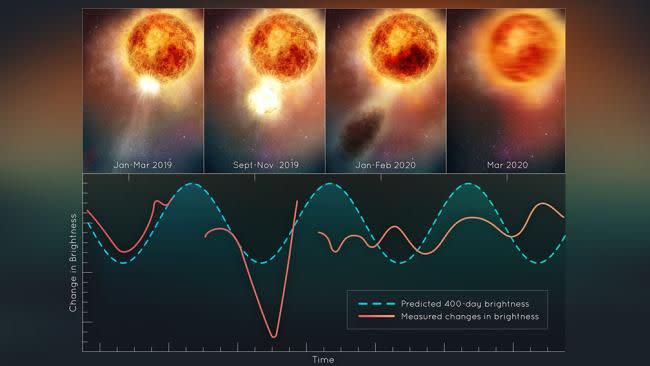Supergiant Star Betelgeuse Blew Its Top in a Violent Explosion, Baffling Scientists

In 2019, the Hubble Space Telescope saw a first when it captured an image of the star Betelgeuse experiencing a surface mass ejection.
Hubble’s observations provide evidence for how a star acts after a significant loss of mass.
Calling it a “titanic convulsion,” scientists see the aging star’s history as a subject for future research.
When the bright, red supergiant star Betelgeuse blew its top in 2019, the Hubble Space Telescope and other observatories were there to see it. Through this surface mass ejection, Betelgeuse offloaded 400 billion times as much mass as the sun does during a typical coronal mass ejection, a regular event in which the sun casts off part of its outer atmosphere, called the corona.
This wasn’t some sort of supernovae finale event, though. Betelgeuse—one of the most prominent stars in the Milky Way, a part of the Orion constellation—still seemingly acts like a normal star, and may even be recovering. After analyzing the 2019 data, astronomers have concluded that this is behavior we’ve never seen before in a normal star.
“Betelgeuse continues doing some very unusual things right now,” Andrea Dupree, a researcher with the Center for Astrophysics, a collaboration between the Smithsonian Astrophysical Observatory and Harvard College Observatory, says in a news release. “The interior is sort of bouncing.”
The 2019 surface mass ejection popped the top off of Betelgeuse, and recovery from something so devastating is a tough path. But the observations from a mix of sources—we’re talking everything from the STELLA Robotic Observatory to the Fred L. Whipple Observatory’s Tillinghast Reflector Echelle Spectrograph (TRES), and NASA’s Solar Terrestrial Relations Observatory spacecraft to the American Association of Variable Star Observers—coupled with the pivotal new data from Hubble, give insight into how an aging star loses mass as its nuclear fusion furnaces burn out.
“We’ve never before seen a huge mass ejection of the surface of a star,” Dupree says. “We are left with something going on that we don’t completely understand. It’s a totally new phenomenon that we can observe directly and resolve surface details with Hubble. We’re watching stellar evolution in real time.”
Betelgeuse is so prominent in the Milky Way galaxy that such a magnificent event not only provides plenty of world firsts in the study of stars, but may continue offering up a knowledge base on how stars act before, during, and after a significant surface mass ejection. Given that this event is happening before any ultimate supernovae event—and there’s no evidence that will imminently occur—there may be plenty of time to observe the progression.

Researchers now believe the 2019 event came from a convective plume more than a million miles across from deep inside the star. The shocks and pulsations blasted off a chunk of the photosphere, leaving a cool surface area under a cloud of dust. This fractured piece, several times heavier than the moon, dimmed the star so much the difference could be seen without a telescope.
The supergiant star’s well-chronicled 400-day pulsation rate is gone, and Dupree says the star’s interior convection cells driving the pulsation may be “sloshing around like an imbalanced washing machine tub.” Data from Hubble and TRES suggest the outer layer may have recovered, but the surface is “bouncing like a plate of gelatin dessert as the photosphere rebuilds itself.”
You Might Also Like

